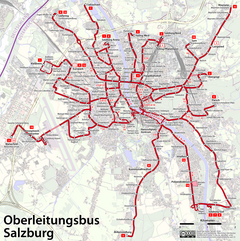| This article includes a list of general references, but it lacks sufficient corresponding inline citations. Please help to improve this article by introducing more precise citations. (August 2011) (Learn how and when to remove this message) |
| Salzburg trolleybus system | |||
|---|---|---|---|
 A Solaris Cegelec Trollino 18 in Salzburg, 2012 A Solaris Cegelec Trollino 18 in Salzburg, 2012 | |||
| Operation | |||
| Locale | Salzburg, Austria | ||
| Open | 1940 (1940) | ||
| Status | Open | ||
| Routes | 12 (1, 2, 3, 4, 5, 6, 7, 8, 9, 10, 12, 14) | ||
| Owner(s) | Salzburg AG | ||
| Operator(s) | Salzburg AG | ||
| Infrastructure | |||
| Electrification | 600 V DC | ||
| Depot(s) | 1 | ||
| Stock | 118 articulated trolleybuses | ||
| Statistics | |||
| Route length | 146.45 km (91.00 mi) | ||
| |||
| Website | https://web.archive.org/web/20100127024936/http://www.salzburg-ag.at/verkehr/stadtbus Salzburg AG (in German) | ||
The Salzburg trolleybus system forms part of the public transport network serving Salzburg, capital of the federal state of Salzburg in Austria. Opened on 1 October 1940, it replaced the Salzburg tramway network [de].
One of only two such systems currently operating in Austria, the Salzburg trolleybus system is one of the largest trolleybus systems in western Europe. It presently carries 41 million passengers each year.
Together with the Salzburger Lokalbahn, the system is currently operated by Salzburg AG [de], which markets it under the name StadtBus Salzburg. It is also integrated into the Salzburger Verkehrsverbund [de] fare collection system. Along with the Salzburg S-Bahn, it forms the backbone of Salzburg's public transport network; the city's diesel bus network, operated by Albus Salzburg [de], plays only a minor role.
History
On 1 October 1940, trolleybus service was introduced in Salzburg, on the Siegmundsplatz–Maxglan route, which is now part of line 1. A few days later, on 24 October 1940, the extension to Makartplatz followed, and on 10 November 1940, the line was further extended, to Salzburg Hauptbahnhof. On 16 February 1942, the ring lines M and L (Maxglan–Lehen–Hauptbahnhof–Zentrum–Maxglan) came into operation. In the following years, the Salzburg trolleybus system recorded rapid growth, but the tramway network was destroyed.
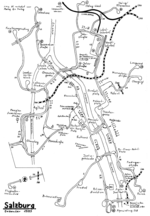
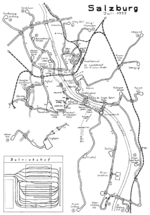
Until the merger in 2000 of the Salzburger Stadtwerke with the SAFE (Salzburger AG für Energiewirtschaft) to create the Salzburg AG, the Salzburg trolleybus system, and the local railway line to Lamprechtshausen, were operated by the Salzburger Stadtwerke - Verkehrsbetriebe. Some diesel bus lines also originally belonged to the company, but in the course of the 2000 merger these were transferred to Albus Salzburg.
Since 2000, therefore, the trolleybus and diesel bus services have been fully separated, both organisationally and operationally. It follows that Salzburg AG is one of the few transport companies worldwide that operates trolleybus lines, but no diesel bus lines.
In 2004, trolleybus line 1 was extended about 500 m (1,600 ft) from Messezentrum to Salzburgarena. Unusually, however, the new terminal was served only during events. At other times, power to the overhead lines in this area is switched off; the status of the overhead lines is displayed to the trolleybus drivers by means of a signal light.
On 1 October 2005, line 1 was extended from Europark to Kavaliershaus, via the EM-Stadion. On 11 December 2005, the extension of line 2 came into operation from the Hauptbahnhof to Obergnigl via Mirabellplatz and the Sterneckstraße.
A non-revenue section [de] of overhead line from the Versorgungshausstraße (line 2) via the Fürbergstraße to the Fadingerstraße was built in the spring of 2006. Especially during events in the city centre, and during the UCI Road World Championships 2006, it has been used intensively. Since then, the trolleybuses of lines 2 and 4 have operated on and off over this route. This section was the basis for the later electrification of the former Albus line 20.
Also, until September 2006 the Gaswerkgasse / Ignaz-Harrer-Strasse intersection, and the Hauptbahnhof area around the Forum-Kaufhaus/Fanny-von-Lehnert-Straße, were provided with additional turning and reversing capabilities. Likewise, since the spring of 2007 a non-revenue section has been in operation from the Landeskrankenhaus (line 7) to Willibald-Hauthaler-Straße (Line 4), and an additional turning space has been provided at the Makartplatz, in front of the Holy Trinity Church. A new turning facility on the Aiglhofkreuzung from line 4 to line 2 was created in spring 2008, as well as a dedicated lane for trolleybuses in the Griesgasse in the city centre. The latter allows the stacking-and-demand retrieval of trolleybuses in the city centre for events. With the timetable change on 7 December 2007, line 4 was extended from Langwied over the city boundary to Mayrwies, replacing bus line 4A.
In autumn 2008, the Salzburg Municipal Council decided to electrify the branch of bus line 20 to Sam / Lankessiedlung. The route follows that of line 20 from Lankessiedlung, via the Salzburg-Gnigl S-Bahn station, Fuggerstraße, Volksgarten, Hanuschplatz to the Landeskrankenhaus; the line leads back to Hanuschplatz and to Sam, via Edward-Baumgartner-Straße and Karajanplatz. This work was completed in mid-2009, and bus line 20 became trolleybus line 10.
On 9 July 2009, lines 3 and 5 were extended by 500 m (1,600 ft) to the new Itzling Pflanzmann terminus. These were the first privately financed trolleybus sections in Salzburg.
Lines
The eleven lines of the present Salzburg trolleybus system are as follows:

| 01 | Red Bull Arena – Messe (– Salzburgarena) | |
| 02 | Walserfeld – Obergnigl | from 1986 to 2003 part of Line 77 |
| 03 | Salzburg Süd – Itzling Pflanzmann | from 1986 to 2003 Line 51 |
| 04 | Mayrwies/Langwied – Liefering | from 1986 to 2003 Line 29 or 29A |
| 05 | Birkensiedlung – Hauptbahnhof (– Itzling Pflanzmann) | |
| 06 | Parsch – Itzling West | |
| 07 | Salzburg Süd – Salzachsee | from 1986 to 2003 Line 49 |
| 08 | Salzburg Süd – Himmelreich | from 1986 to 2003 part of Line 95 |
| 09 | Europark – Justizgebäude/Kommunalfriedhof | Formerly bus line 20 |
| 10 | Sam – Landeskrankenhaus (– Schule Lehen) | |
| 12 | Josefiau - Europark | |
| 14 | Polizeidirektion - Forellenwegsiedlung |
Projects
In October 2010, plans for new extensions were presented. It is proposed to run line 10 through the Strubergasse in future, and thereby provide a better connection with the Struber barracks. Additionally, by means of a branch in the Karolingerstrasse, line 8 will serve the many businesses and residents in that district. The city of Salzburg plans to invest around €2.2 million in these two projects up to 2015.
For quite some time, an extension to Eugendorf, or a cross-border line to Freilassing in Germany, have also been discussed.
In December 2016, diesel bus line 20 will be converted to trolleybus line 9 with a new 2.2 kilometres (1.4 mi) route in the East of Salzburg.
Fleet
Former fleet




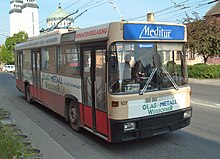
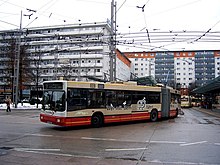

For many years until about 2000, almost all of the trolleybuses operating on the Salzburg system were made either by the German company MAN or its Austrian counterpart Gräf & Stift. After the former company took over the latter in 1971, the Gräf & Stift name remained in use as an MAN brand for the Austrian market and for trolleybuses until 2001, when ÖAF-Gräf & Stift AG was renamed MAN Sonderfahrzeuge AG. With the gradual retirement of Gräf & Stift vehicles after the start of the 21st century, the proportion of the fleet represented by MAN/Gräf & Stift vehicles became smaller and smaller, until retirement of the last such vehicles in 2016.
Some of the retired Salzburg vehicles were sold to other trolleybus operators. By that means, former Salzburg trolleybuses later entered service on the since-closed trolleybus system in Kapfenberg, Austria, and also in Germany (Eberswalde), Lithuania (Vilnius), Romania (Mediaş and Timișoara) and Russia (Perm and Rybinsk).
Until 1975, trolleybuses also operated with trailers. Salzburg was the last trolleybus network in Austria in which this form of operation was to be found. There were four different models of trailer available. They were made by Gräf & Stift (type OA I), Kässbohrer (without model designation), Lohner (type OM 5/1) and Schumann (without model designation).
The first low-floor trolleybuses to be added to the system were the 23 MAN articulated vehicles constructed between 1994 and 1997. One of them, fleet no. 240, was a used vehicle acquired from Kapfenberg. The remainder of the fleet continued to be high-floor vehicles until 2000.
The last two-axle trolleybuses still used in regular service were retired around the end of 2003. These were the last of eight Steyr-built vehicles that were built in 1988. One of the Steyr vehicles, no. 109, was preserved as a heritage vehicles, and for a period starting in September 2005 it ran in regular service again, but as a special vehicle making only a single trip per day in the morning peak period. In 2005, the fleet totalled 92 vehicles.
The last high-floor vehicles in the active fleet, apart from heritage vehicles used only for special services, were retired in July 2016. These were Gräf & Stift articulated trolleybuses built between 1988 and 1994, nos. 200–228. One, fleet no. 220, was bought secondhand from the Kapfenberg trolleybus system.
More new low-floor trolleybuses were purchased from Van Hool in 2000, from Solaris in 2009, and Hess in the 2010s. See "Current fleet" section, below.
Table of former fleet
| Numbers | Quantity | Manufacturer | Model no. | Configuration | Entered service | Last units retired |
Notes |
|---|---|---|---|---|---|---|---|
| 10 | MAN / Schumann | MPE I | Standard (two-axle) | 1940 | 1967 | ||
| 04 | Vétra | CS 60 | Standard (two-axle) | 1941 | 1943 | ||
| 10 | MAN / Schumann | MPE II | Standard (two-axle) | 1942 | 1966 | ||
| 06 | Gräf & Stift | EO I | Standard (two-axle) | 1948 | 1974 | ||
| 01 | MAN / Gräf & Stift | EO I | Standard (two-axle) | 1951 | 1971 | ||
| 03 | MAN / Gräf & Stift | EO II | Standard (two-axle) | 1956 | 1970 | ||
| 03 | Uerdingen / Henschel | ÜHIIIs | Standard (two-axle) | 1956 | 1976 | ||
| 05 | Henschel | HS 160 OSL-G | Articulated | 1961 | 1979 | ||
| 129–135 | 07 | Gräf & Stift | GEO II | Articulated | 1961 | 1980 | Originally numbered 136–142; renumbered in 1965. |
| 136–140 | 05 | Gräf & Stift | GE 105/54/57 | Articulated | 1964 | 1983 | Originally numbered 146–150; renumbered in 1965. |
| 141–147 | 7 | Gräf & Stift | GE 105/54/54 | Articulated | 1966 | 1984 | |
| 148–152 | 5 | Gräf & Stift | GE 105/54/54/1 | Articulated | 1970 | 1987 | |
| 101–112 | 12 | Gräf & Stift | OE 105/54 | Standard (two-axle) | 1971 | 1990 | |
| 153–154 | 2 | Gräf & Stift | GE 105/54/54/2 | Articulated | 1972 | 1989 | |
| 113–123 | 11 | Gräf & Stift | OE 110/54/A | Standard (two-axle) | 1975 | 1993 | |
| 155–160 | 06 | Gräf & Stift | GE 110/54/57/A | Articulated | 1976 | 1992 | |
| 161 | 01 | Gräf & Stift | GE 150 M 16 | Articulated | 1979 | 1993 | Induction motor |
| 129–147, 162–186 | 44 | Gräf & Stift | GE 110 M 16 | Articulated | 1978–85 | 2002 | No. 178 now a heritage vehicle. |
| 101–106 | 06 | Gräf & Stift | OE 112 M 11 | Standard (two-axle) | 1986 | 2002 | |
| 107–110 | 04 | Steyr | STS 11 HU | Standard (two-axle) | 1989 | 2003 | No. 109 now a heritage vehicle. |
| 111–114 | 04 | Steyr | STS 11 HU 140 | Standard (two-axle) | 1990 | 2003 | |
| 200–228 | 27 | Gräf & Stift | GE 112 M 16 | Articulated | 1989 | 2016 | No. 220 now a heritage vehicle. |
| 230–252 | 23 | Gräf & Stift/MAN | NGT 204 M16 | Articulated | 1994 | 2016 | 240 = ex-Kapfenberg no. 35, in the fleet since 2003. |
| 259–260 | 02 | Van Hool | AG 300 T | Articulated | 2012 | 2014 | Formerly VMCV nos. 2 and 15, in the fleet since 2009, without automatic current collector. |
| 316–319 | 04 | Solaris | Trollino 18 | Articulated | 2013 | 2024 | Formerly La Chaux-de-Fonds, Switzerland, nos. 141–144, built in 2005 and acquired in 2013. |
Current fleet
-
 A Van Hool AG300T on route 1 in 2012
A Van Hool AG300T on route 1 in 2012
-
 Solaris Trollino 18 no. 311 in 2015
Solaris Trollino 18 no. 311 in 2015
-
 One of the Solaris Trollino "MetroStyle" trolleybuses in 2014
One of the Solaris Trollino "MetroStyle" trolleybuses in 2014
-
 A Hess "Swisstrolley" trolleybus on route 3 in 2021
A Hess "Swisstrolley" trolleybus on route 3 in 2021
The oldest vehicles in the current fleet are the Van Hool AG300T trolleybuses, built in 2000–2003. Of the 32 Van Hool vehicles, 13 were equipped with a diesel-powered auxiliary drive, the first such devices to be fitted to vehicles in the Salzburg fleet. On 24 November 2008, two more Van Hool articulated vehicles arrived in Salzburg as secondhand acquisitions from the Montreux–Vevey trolleybus system, in Switzerland. These had been Montreux–Vevey fleet nos. 2 and 15, built in 1993/94, and were renumbered 259–260 in Salzburg. Following renovation work, including repainting into the dark-red-and-white livery used on the trains of the Salzburger Lokalbahn, they were placed in service in March 2009.
Of the next generation of trolleybuses, 15 Solaris Trollino 18s, the first three were delivered on 14 September 2009. Eight more followed in 2010, and the remaining four in 2011. The Solaris vehicles were painted dark red and have an auxiliary drive, to allow movement away from the overhead wires. In February 2010, one Solaris vehicle, fleet no. 301, was loaned to the Eberswalde trolleybus system in Germany for presentation purposes. (Four more trolleybuses of the same type were acquired secondhand from Solaris in 2013, after the La Chaux-de-Fonds system closed and returned the vehicles to the manufacturer; the last of these were retired in 2024.)
In 2012, Salzburger Lokalbahn (SLB) became the operator of the trolleybus system, and its livery of red-and-white (previously applied only to the two ex-Montreux–Vevey vehicles) was given to the Solaris Trollino vehicles, along with branding "Obus SLB" on the front ends—Obus being the German word for trolleybus.
Additional Solaris Trollino 18 vehicles were ordered subsequently, and beginning with number 321, they received Solaris's then-new "MetroStyle" body, with a more sloped front design similar to the design of Solaris's Tramino trams. They also introduced a new version of the system's livery, with red and black (with a white waist stripe) instead of red and cream or white. The first, no. 321, was delivered in May 2012, and the total number of Solaris Trollino MetroStyle trolleybuses ultimately reached 51, with the last arriving in 2018.
At the beginning of 2020, the total size of the active fleet was 120, not counting preserved vehicles.
An order was placed in November 2021 with Hess, of Switzerland, for 15 BGT-N1D trolleybuses, later reported to be the "lighTram 19DC" model rather than BGT-N1D. The first unit (no. 402) was delivered in August 2019 and entered service in September, and the last had been received by February 2020, by which time seven more had been ordered. Additional orders placed subsequently increased the total number of Hess trolleybuses in the fleet to 42 by 2023, the last deliveries being of nos. 439–442 in October 2023.
Table of the current fleet
| Numbers | Quantity | Manufacturer | Electrical equipment |
Year built | Model | Low-floor | Auxiliary drive | Notes |
|---|---|---|---|---|---|---|---|---|
| 261–290 | 30 | Van Hool | Kiepe | 2000–2005 | AG300T | yes | yes (261, 279–290) no (262–278) |
|
| 301–315 (Trollino) 321-371 (Trollino Metrostyle) |
66 | Solaris | Cegelec | 2009–2018 | Trollino 18 | yes | yes | The Metrostyle is a trolleybus with a design inspired by the Solaris trams. |
| 401–442 | 42 | Hess | 2009–2023 | lighTram 19DC | yes | yes |
Heritage fleet

The oldest operable trolleybus in Salzburg is a 1957 model ÜHIIIs. Although this type of trolleybus operated in Salzburg (from 1956 to 1976), this is not an original Salzburg vehicle. With the fictitious number 123, it comes from the Solingen trolleybus system (former number 40) and has been loaned by an English collector.
Since July 2007, the ÜHIIIs has been operating special trips in Salzburg, for which it wears a Salzburg livery. The vehicle can also be hired privately. From late July to late August each year, to coincide with the Salzburg Festival, the ÜHIIIs ran on a regular basis every Friday, on a special heritage line of the Association Pro Obus Salzburg eV. This service has continued in most subsequent summers, including in 2018 and 2019, on one Friday in each of June and July (also one day in May in 2018) and all Fridays in August.
Two other serviceable heritage vehicles, also in the care of Pro Obus Salzburg eV, are the 1985-built Gräf & Stift articulated trolleybus no. 178, and the 1988-built Steyr conventional (two-axle) trolleybus no. 109.
See also
References
Notes
- "Solaris-Busse: Neue Fahrzeugflotte in Salzburg" [Solaris-Buses: New vehicle fleet in Salzburg]. Salzburg24.at. 22 December 2010. Retrieved 29 September 2011.
- ^ Murray, Alan (September–October 2005). "Salzburg Celebrates 65 Years". Trolleybus Magazine. No. 263. UK: National Trolleybus Association. pp. 98–113. ISSN 0266-7452.
- "MAN Nutzfahrzeuge Annual Report 2001" (PDF). MAN Nutzfahrzeuge. 15 March 2002. pp. 10–11. Retrieved 2010-11-16.
- Trolleybus Magazine No. 265 (January–February 2006), p. 13. National Trolleybus Association (UK).
- Trolleybus Magazine No. 330 (November–December 2016), p. 178. National Trolleybus Association (UK). ISSN 0266-7452
- Trolleybus Magazine No. 307 (January–February 2013), p. 16.
- Trolleybus Magazine No. 313 (January–February 2014), p. 16.
- Trolleybus Magazine No. 284 (March–April 2009), p. 34. National Trolleybus Association (UK). ISSN 0266-7452
- Trolleybus Magazine No. 286 (July–August 2009), p. 85. National Trolleybus Association (UK). ISSN 0266-7452
- ^ Trolleybus Magazine No. 305 (September–October 2012), p. 114. National Trolleybus Association (UK). ISSN 0266-7452
- Trolleybus Magazine No. 347 (September–October 2019), p. 186. National Trolleybus Association (UK).
- ^ Trolleybus Magazine No. 350 (March–April 2020), p. 166. National Trolleybus Association (UK). ISSN 0266-7452
- Trolleybus Magazine No. 343 (January–February 2019), p. 26. National Trolleybus Association (UK).
- Trolleybus Magazine No. 348 (November–December 2019), p. 224. National Trolleybus Association (UK).
- Trolleybus Magazine No. 373 (January–February 2024), p. 30. National Trolleybus Association (UK).
- Trolleybus Magazine No. 339 (May–June 2018), p. 106. National Trolleybus Association (UK).
- Trolleybus Magazine No. 346 (July–August 2019), p. 146. National Trolleybus Association (UK).
Books
- Fuchs, Alois (1996). Salzburgs Nahverkehr [Salzburg's Local Transport] (in German). Salzburg: Verlag Alfred Winter. ISBN 3-85380-053-X.
- Mackinger, Gunter (2005). Der Obus in Salzburg [The Trolleybus in Salzburg] (in German). Salzburg: Verlag Kenning. ISBN 3-933613-74-4.
External links
![]() Media related to Trolleybuses in Salzburg at Wikimedia Commons
Media related to Trolleybuses in Salzburg at Wikimedia Commons
- "Trolleybus city: Salzburg". Trolleymotion.
- Salzburg database / photo gallery and Salzburg trolleybus list at Urban Electric Transit – in various languages, including English.
47°48′N 13°02′E / 47.800°N 13.033°E / 47.800; 13.033
| Urban public transport networks and systems in Austria | |||||
|---|---|---|---|---|---|
| S-Bahn |  | ||||
| U-Bahn | |||||
| Tram | |||||
| Trolleybus |
| ||||
